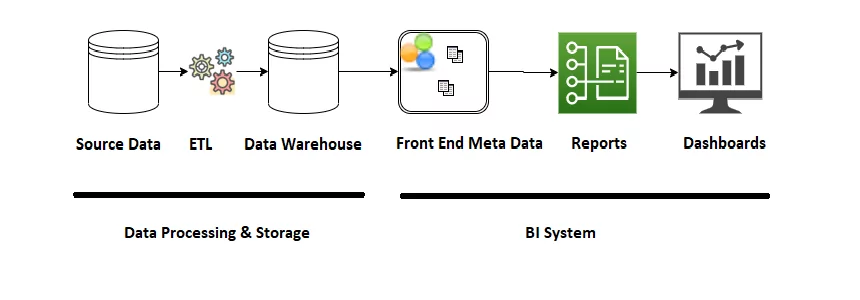4 Easy Techniques for BI Testing: Every QA Expert Must Know

alphabold
Introduction
Accurate and timely information can make or break a business. Companies from various industries generate massive amounts of data daily, and with technological advancements, this data can be leveraged to gain a competitive edge. However, regrettably, many organizations remain unaware of the potential of Business Intelligence and the techniques for BI testing.
BI helps organizations make data-driven decisions, leading to a significant competitive advantage in the marketplace. This data can decode insights, drive informed decision-making, and fuel innovation. By analyzing the vast volumes of information, businesses can identify patterns, trends, and correlations that may have previously gone unnoticed. However, BI systems rely on data from various sources, and it’s crucial to ensure that the data being used for analysis and reporting is accurate, complete, and consistent. BI testing helps identify and rectify data quality issues, ensuring business decisions are based on reliable information. This article will delve into the essential techniques that every QA expert must know to excel at techniques for BI testing but before we do, let’s explore some basic concepts of the field.
What is BI and How to Develop Techniques for BI Testing?
Business Intelligence (BI) is a process that involves obtaining, cleaning, analyzing, integrating, and sharing data to derive actionable insights that drive corporate progress. BI testing, also known as BI validation or BI quality assurance, is vital to this process. It is the process of evaluating the data used in the BI process, including the staging data, ETL process, and BI reports, to ensure that it is accurate and complete.
BI testing ensures the data is correctly integrated, transformed, and loaded into the BI system. This includes validating that the data is complete and accurate and that the ETL processes function as intended. It also includes testing the BI reports and dashboards to ensure that they provide real and meaningful insights to the users. BI testing aims to identify and correct errors or inaccuracies in the data, ETL process, or reports before they impact decision-making.
Enhance your BI Testing Framework
Ready to optimize your techniques for BI testing? Connect with our experts and discover how we can help streamline your QA operations.
Request a DemoGuide to Learn Techniques For BI Testing

Two Step Data Pipeline
1. Data Processing & Storage:
Data Processing and storage is further categorized into ‘Source Data,’ ‘ETL,’ and ‘Data Warehouse’.
Source Data: Data for BI systems is gathered from various sources and programs, including CRM, ERP, and OMS. Since the data is extracted from multiple sources, the data in the source system may have problems. For example, instead of 100, the sales number could be 1000. The source data is not under the control of BI teams. The data issue, though, can cascade down to reports. Therefore, it is critical to validate the integrity of the data source.
ETL: Data from the source system is extracted, transformed, and loaded into the data warehouse. The transition from OLTP (Online Transactional Processing) to OLAP (Online Analytical Processing) is a critical process that involves several steps and requires careful planning and execution. This transformation is prone to mistakes, errors, missteps, and miscalculations. For example, a file may be loaded twice by mistake. Customer data needs to be correctly integrated because the names need to match. Only thorough testing of the ETL process can eliminate such issues.
Data Warehouse: Even if no errors are discovered during source testing, the data warehouse could be the source of the issue. There is a chance that some orders can be missed in the data warehouse, resulting in these issues. It’s also possible that the data for these orders was accidentally misplaced.
2. BI System:
BI system consists of ‘Data Layer’, ‘Reports’ and ‘Dashboards’.
Data Layer: Data layers make high-level information accessible to business users. The information displayed is derived from databases and is classified as soft data transformations. The data layer should be tested, as there is a fair chance of error during development.
BI Reports: A BI report is made up of SQL queries and filters. These items might have problems due to technical specifications or development errors. Building a BI report is a development activity that must be tested to ensure quality.
Dashboards: Multiple reports with various data and visuals are combined into a dashboard. There may or may not be any relationship between them. Most of the time, these dashboards are the final products used by the companies so testing these dashboards is crucial.
How to Develop Successful Techniques for BI Testing?
- Test Scope: Your test should include a description of all testing techniques and types you plan to use.
- Test Environment: This step guarantees that the testing environment is ready and set up for running tests.
- Test Data: Make sure you have access to test data, such as data that includes information for all possible business scenarios.
- Data Quality: List the BI quality assurance and performance acceptance criteria for their BI testing
Steps Involved in BI Testing Methodology
1. Data Acquisition:
The basic goal of data acquisition is to ensure that all the information needed for loading to the destination has been received. The following are the keys stages of this phase:
- Verifying the availability of the data sources and the necessary data.
- Data profiling aids in processing the provided information, particularly in the early phases of detecting the various data values, issues, and value constraints. Testers can control the project cost by pinpointing and resolving any underlying issues earlier.
Maximize Data Integrity and Performance
Leverage our expertise and techniques for BI testing to gain actionable insights and drive business success. Reach out to us for a tailored solution.
Request a Demo2. Data Integration:
The testing carried out during the data integration stage is of utmost importance since this is when data transformation occurs. As all business requirements are turned into transformation logic, BI testing must ensure that the information complies with the intended transformation logic. The following are the keys stages of this phase:
- The data model should be validated, including data structure adhering to business requirements.
- Verify the project’s metadata usage through a data dictionary review.
- Traceability is ensured throughout the process via source validation to target mapping.
3. Data Storage:
The warehouse or OLAP cubes are loaded with company data at this phase. The data can be loaded sequentially, continuously, or progressively depending on preference.
The following are the critical points of this phase:
- Data load validation is validating information loads against specified time intervals.
- The system is tested under initial and subsequent loads to ensure it operates within acceptable boundaries.
- Verifying parallel execution could affect the system’s performance and scalability.
4. Data Presentation:
The data presentation is the last phase of the BI testing cycle. In this stage, the tester works on:
- Verifying the report model to see if any errors were missed.
- Reporting layout verification in line with business requirements and mockups.
- End-to-end testing to ensure that the entire system will function as intended.
BI Testing Tools
The following are the tools that are most frequently used in BI testing:
- Microsoft Power BI
- Microsoft SQL Server
- Oracle BI
- Apache Impala
- Pentaho
Bonus Read: Top 16 Business Intelligence (BI) Tools in 2024
Conclusion
Businesses wishing to make smarter, more informed decisions must have access to BI. Many companies rely on techniques for BI testing to better understand market trends and their competitors while improving the user experience.
If you are looking for a BI testing service provider, you should consider AlphaBOLD. We have experts who can efficiently lead the entire QA phase for your software product.
Explore Recent Blog Posts







